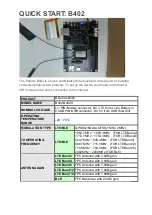
Page 2 MX31 Cab, MX31FU Radio Cab
0. What’s new?
since MX21
The MX31 tethered and MX31FU radio cabs replace the MX21 and MX21 radio cabs, which them-
selves were a further development of the MX2 and MX2FU respectively.
This chapter is placed ahead of the actual instruction manual and describes the substantial differ-
ences between the new MX31 cab and its predecessor, the MX21. It is not meant to be a complete
list of features -- because the MX21 was already equipped with ample features.
Some of the features described in this manual will be added later with software updates. These up-
dates can be down loaded at no charge from ZIMO’s web site
www.zimo.at
and installed with the
help of the ZIMO Service Tool (ZST). Updates are also necessary to correct software errors and
glitches that are unavoidable after a certain complexity is reached, to take customer experiences and
desires into consideration and to adapt the product to possible changes in industry standards.
Generous, future-oriented MX31 hardware
The user interface has been optimized and many important elements were added, without compro-
mising the proven basic layout of the previous cab:
LCD display 112 x 64 pixel, three-colored back ground illumination - readable in daylight – 26 keys –
1 slider – 1 thumbwheel encoder – 21 three-colored LED’s for functions and direction indication as
well as for the light bar – 6 LED’s for key illumination, yellow – 1 daylight sensor.
The MX31 is built for highest performance: 32 bit – 60MHz processor, 256KB Flash-EPROM, 16KB
RAM, 8Mbit serial Flash memory.
Three operating modes: GUEST - OPERATOR - EXPERT
ERXPERT from SW-Version 1.10, GUEST from SW-Version 1.12 (November 2006)
The OPERATOR mode is similar in presentation and range of functions to the MX21 but is easier to
read due to the larger display.
The GUEST mode limits the range of functions – usually limited to the control of one train so that
guests or children not familiar with the system won’t interfere with operations due to erroneous cab
inputs. This mode is password protected.
The EXPERT mode fully utilizes the technical possibilities with the maximum amount of information
displayed – up to 8 lines.
More than 12 functions
Implementation with future SW updates in 2006
This is useful for the many new features in today’s decoders and sound decoders. New NMRA RP’s
are in preparation.
Name allocation for complete trains and stations
Implementation with future SW update in 2006
Names can be used for single loco and accessory addresses – as was possible with the MX21 – but
also for consists. In this way, a double-header can be displayed with one name in large writing, fol-
lowed by the two loco addresses or names; for example: SAN ANTONIO and below EMD and SD40.
Provisions are made to comfortably switch between the locos of a consist for accessing individual
functions. The MX31 provides soft-keys for adding or subtracting (ADD, SUB) locos to/from a consist
– important for North-American operating methods!
Using names for routes containing several accessory addresses is also possible, which, in the future,
can also be displayed as small track schematics.
Icons and unlimited function key assignments
RG-key available with initial SW version, rest to follow with future SW updates in 2007
9 function icons can be displayed in grid formation (headlight, whistle, horn, turnout etc) in the lower
half of the display that not only identifies each key’s intended function but also its current state – the
latter is especially useful in direct sunlight where the function LED’s may be hard to see.
The user interface can further be enhanced by altering the effect of each number key from their stan-
dard function key assignments (including several function actuation with one key), so that a uniform
meaning of the keys can be achieved for all engines of a layout or for a certain class of engines.
Uniform shunting key “RG” – independent of decoder type
“low gear” operational with initial SW, rest to follow with future SW update in 2006
Shunting functions offered by many decoders (low gear, momentum turned off) are of practical im-
portance but are usually allocated to different function keys (F3, F4 etc.). The new “RG” key offers a
solution to this dilemma by allowing a flexible allocation of these functions to this uniform key.
Multi-level menu structure
Implemented with SW update 1.10
Several functions that were already available with the MX21 as well as new functions are now also
accessible through menus (if the key combinations are not known, e.g. name or route definitions).
There are 3 menu levels:
OPERATIONS menu for driving, turnouts, programming (e.g. list of names, shunting key allocation
etc.).
The SYSTEM menu for things like the system clock, command station CV’s and module CV’s (MX8,
MX9).
The CAB menu for language selection, dimming, timeouts, soft keys and much more.
Simultaneous display and handling of two applications
Implementation with future SW update is planned for 2006
With the cab in the EXPERT mode, the upper and lower halves of the display are assigned to two dif-
ferent tasks. For example: control of an engine (displayed in upper half) and simultaneous scrolling
through memory (displayed in lower half) or driving and simultaneous observation of an operating
sequence (an “AOS” E procedure); but, most of all, the simultaneous control of two engines as de-
scribed in the next section.
Simultaneous control of two engines (or trains)
Implementation with future SW update in 2006
While an engine is controlled with the primary controls of speed slider, direction key and function
keys, a second engine can be controlled using the encoder thumbwheel for speed and directions.
This is especially useful for shunting work or assembling/disassembling of consists.
Содержание MX31FU
Страница 6: ...Page 6 MX31 Cab MX31FU Radio Cab 4 QUICK GUIDE...
Страница 7: ...MX31 Cab MX31FU Radio Cab Page 7...
Страница 29: ...MX31 Cab MX31FU Radio Cab Page 29...


































